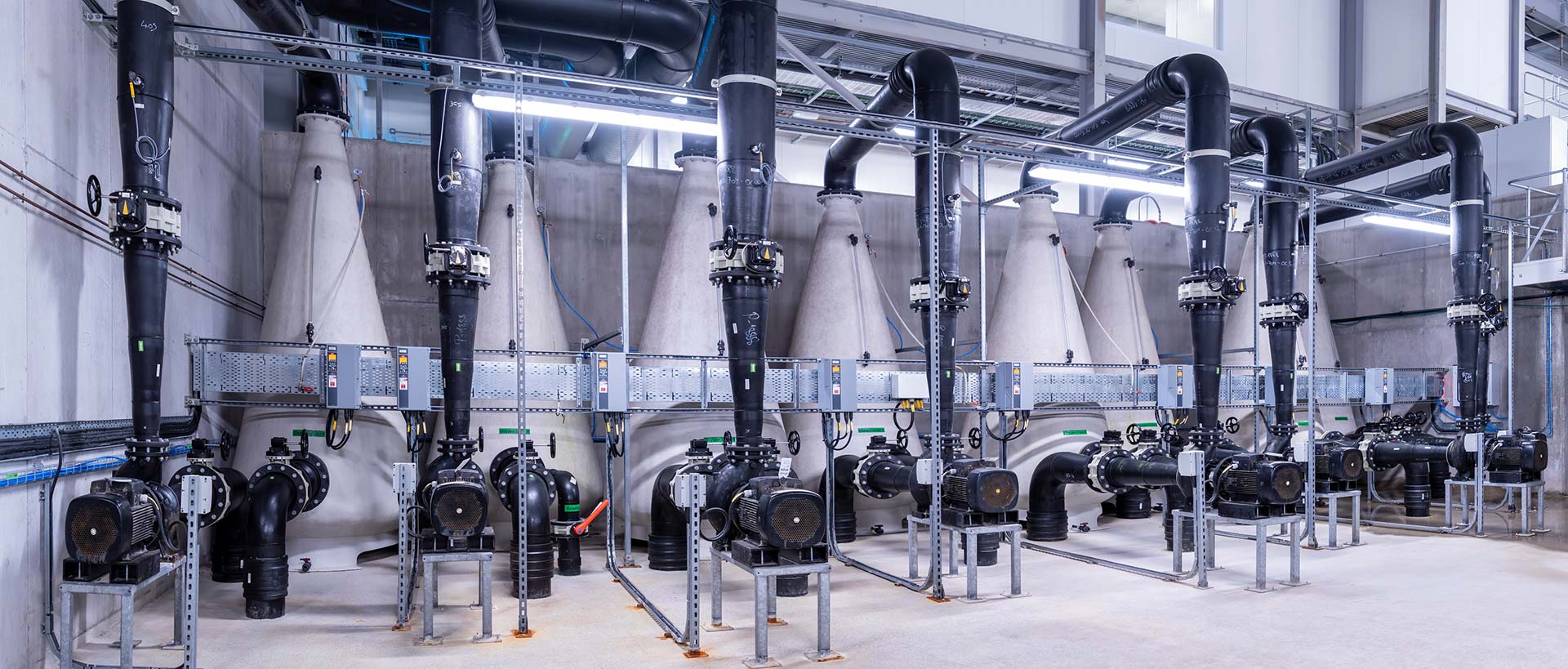Why RAS?
Why choose RAS?
Recirculating Aquaculture Systems (RAS) represent a transformative approach to sustainable fish farming. By reusing water through advanced filtration and treatment processes, RAS minimizes resource consumption while providing optimal conditions for fish health and growth. This technology offers unparalleled control over production parameters, ensuring efficient, biosecure, and environmentally responsible aquaculture operations.
RAS Advantages
These advantages make RAS a reliable and sustainable choice for meeting the increasing global demand for high-quality seafood.

Our RAS
1Fish Tanks
Inlets and outlets are designed to ensure fast removal of feces and uneaten feed pellets and provide optimal conditions for the fish. Fish tank sizes can vary from a few cubic meters to several thousand cubic meters of water. The most commonly used materials are fiberglass, concrete and PE.
2Mechanical Filtration
Particles such as feces and uneaten feed pellets are removed from the water using drum filters with a typical mesh size of 40-90 μm, depending on fish size and species. This process is vital for fish welfare and the stability of other water purification processes.
3Water Reservoir 1
After passing through the mechanical filtration process, water is accumulated in Reservoir 1 and is then directed to the biofiltration system.
4Water Lifting
Highly efficient centrifugal or propeller pumps are used to lift the water from Reservoir 1 to the biofiltration system.
5Biological Filtration
Fixed or moving bed biofilters break down soluble organics and ammonia to their lowest possible level, thus providing excellent water quality for the fish. The bioreactor is the heart of our RAS solution, as it maintains microbial stability in the system and captures fine solids, making the Globaq’s RAS best-in-class when it comes to water clarity.
6Uv Disinfection
Water is exposed to powerful UV radiation before entering the fish tanks to control bacteria counts and reduce the risk of virus outbreaks.
7Degassing
The degasser provides effective stripping/degassing of carbon dioxide (CO2) and nitrogen (N2). At the same time, process water is oxygenated to approximately 100% saturation.
8Water Reservoir 2
After being degassed, water is accumulated in Reservoir 2.
9Oxygenation
To meet the fishes’ oxygen demands inside the fish tanks, pure oxygen is injected into the water. Typical methods of injecting oxygen into water include the use of oxygen cones for fresh and sea water and low head injectors for brackish and sea water.
10Fish Feeding
In order to assure optimal and precise delivery of feed to each fish tank, we design and deliver fully automatic fish feeding systems, including silos, transportation systems and decentralized feed stations.
11Primary Intake Water Treatment
A combination of mechanical filtration and high-dose “firewall” UV disinfection provides the quality of water needed for RAS.
12Ph And Alkalinity Regulation
Nitrification activity in the biological filter causes a drop in the water’s pH level. This reduction is compensated by automatic dosing of alkali, such as lime or lye.
13Temperature Control
Maintaining stable temperatures within a defined temperature range is important for efficient and predictable fish production. We deliver high - end temperature regulation solutions for the aquaculture industry, including heat pumps/chillers, heat exchangers.
14Salinity
In order to meet the specific salinity requirement of each fish species / life stage, Globaq Aquaculture RAS integrates an automatic salt / sea water addition system.
15Sludge Treatment
We offer a wide range of solutions for sludge dewatering. Depending on the later use of the sludge, our solutions can produce sludge with dry matter content ranging from 30% dry matter.
16Grading
As part of our integrated design, we include overall fish logistics in our delivery. This includes transporting fish from the rearing tanks to the handling area, grading platforms, grading equipment, counting, pumping equipment and fish distribution pipes back to the tanks.
17Control System
We offer a broad range of control options customized to each client’s needs, from local PLC units to mobile and remote-controlled software, all of which provides full control and management of the facilities.
Sustainability
By the year 2050, the world’s population will have grown to 9.1 billion people, 34% greater than today, and practically all of this increase will take place in developing countries.
